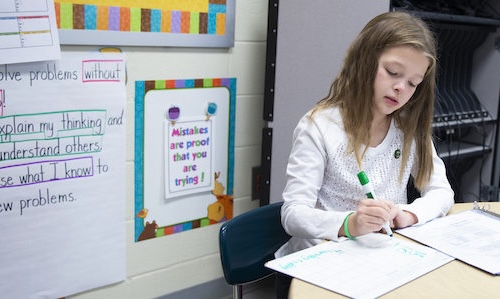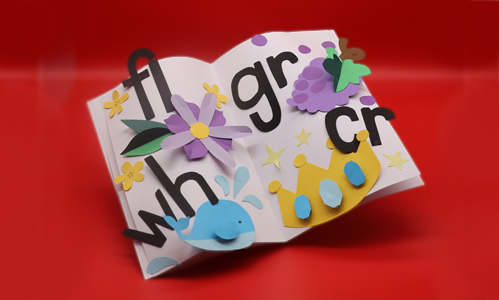 At NWEA, we’re fortunate to have relationships with districts all over the world, partnering with them in their data-rich journeys and learning from the inspirational work they do with their students. One such district is Schiller Park, in Illinois, where our researchers identified incredible growth scores—scores that measure an individual student’s progress over time, no matter the initial starting place—among their comparatively “normal” district conditions. When outliers were accounted for, the facts remained: something magical is happening in the classrooms at Schiller Park, including with self-paced math.
At NWEA, we’re fortunate to have relationships with districts all over the world, partnering with them in their data-rich journeys and learning from the inspirational work they do with their students. One such district is Schiller Park, in Illinois, where our researchers identified incredible growth scores—scores that measure an individual student’s progress over time, no matter the initial starting place—among their comparatively “normal” district conditions. When outliers were accounted for, the facts remained: something magical is happening in the classrooms at Schiller Park, including with self-paced math.
As we dove deeper into the partnership, Schiller Park became a laboratory of sorts. We studied the behaviors and results, which yielded our guide detailing ten transformative teaching strategies for those wishing to replicate its success.
While in a webinar with Schiller Park district leaders, I also heard an anecdote that, as a math teacher, was impossible to ignore. Born from the need to differentiate to many varying math levels in the classroom, Schiller Park teachers devised a self-paced math classroom that allows students to truly work at their own pace. Questions exploded in my mind. How long does this process take? How many students can be supported at a time? What are the challenges? And, most importantly, how do I do it?
I was lucky enough to sit down with the district’s leadership team and two math teachers at the district’s Lincoln Middle School to talk through the nitty gritty specifics—and no wonder these schools are seeing high growth. Did they find the eleventh transformative teaching strategy?!
One teacher’s summer project
As most things in schools do, it began with a truly passionate educator.
Faced with the challenge of meeting a wide range of student abilities in a single classroom, Alison spent her summer crafting a bold new plan: a classroom where every student could learn at their own pace. Armed with a deep understanding of her students’ needs and a commitment to making math accessible, she created the first iteration of the program. What started with paper worksheets quickly evolved into a tech-enabled model, thanks to district support and the creativity of her colleagues. Over time, the program expanded, becoming a cornerstone of Schiller Park’s success story.
Now, Alison and Bill, sixth- and eighth-grade math teachers, spearhead Schiller Park’s self-paced math classrooms with a loving (if slightly exhausted!) dedication inherent to teachers who love their jobs. They take each new school year as an opportunity to iterate, perfecting the process from Alison’s “summer dream” to a very real success story.
How it works
Schiller Park’s self-paced math classrooms combine thoughtful planning, educational technology, and a focus on student ownership. Here’s how they do it:
- Power standards and spiraling skills. Teachers identify essential skills, or “power standards,” for each unit and break them into spiraled “tasks” that build on one another. These tasks are numbered and sequential.
- Task design. Each task includes an instructional video (often created by teachers or via platforms like Edpuzzle) and a corresponding work set to practice the skill.
- Diagnostics and placement. Every unit starts with a diagnostic test to determine each student’s starting point. Students with prior knowledge can skip ahead to higher-level tasks.
- Flexible pacing. Students work through tasks at their own pace. Fast movers can complete the unit early and take the summative test ahead of schedule, while others have time to catch up with additional support.
- Engagement and collaboration. Teachers encourage peer collaboration and small-group work while maintaining structured guidelines. This approach creates a dynamic and engaging classroom environment.
- Technology integration. Digital tools like iPads and automated grading systems streamline the process, freeing up teachers to focus on instruction rather than paperwork.
Initial obstacles
No innovation comes without its hurdles, especially without a playbook. Schiller Park teachers reported that grading overload was initially a big obstacle. Teachers spent hours grading different tasks so that students, no matter where they were on their task list, could move ahead. Automation has since reduced their workload; teachers are piloting Classkick this year, which enables them to pre-program correct answers and return them automatically to students.
Teachers also have to frontload a rich volume of tasks for high-achieving students to complete. Students who work quickly or arrive with prior knowledge require a vast library of challenges, which the team continues to build.
And, of course, monitoring many different students as they tackle tasks on their own schedule means a teacher has to be the chef of a very busy kitchen, filling different orders. Teachers must monitor students’ asynchronous journeys through tasks, answering a question about Task #4 in the same breath as a question about Task #11.
The benefits and iterations
Even amidst Alison and Bill’s constant iteration in the face of challenges, the results have been transformative for both students and teachers. Math classes at Schiller Park provide unmatched differentiation, as students of all levels thrive in a classroom designed to meet their unique needs. Meanwhile, empowered educators have more time for meaningful one-on-one interactions with students, including revolving small groups and partnered students.
Inside these small group settings, Schiller Park has noted significant blossoming of English language learners, as they are more comfortable sharing answers and asking questions. All students are reporting newfound excitement about math, which is rendered in their MAP® Growth™ scores; Schiller Park educators are seeing impressive growth scores across the board, especially among high fliers.
As Schiller Park’s math department has learned more over years of this experiment, they have made some changes:
- They moved from paper activities (where students went to folders to get a new worksheet) to video-based work set tasks on tablets, organized through Google Classroom.
- They incorporated existing videos as pre-watch content, which allows students to receive asynchronous mini-lessons. If teachers couldn’t find an existing video they wanted to assign, they began making videos themselves and built up a library.
- They advocated for leveling their math classes, so that high-achieving students weren’t so significantly outpacing their peers who needed extra support. Within more remedial classrooms, they change the formula a bit: there is often a whole-group mini-lesson before students take off on their own journeys.
- They took advantage of an after-school learning center, requiring students who are behind in their tasks to report to this teacher-staffed section to complete their work.
Ready to try it?
Here’s how you can get started with self-paced math in your classroom:
- Start small. Choose one unit or a two-week period to pilot the program. It’s just an experiment!
- Focus on power standards. Identify the most critical skills for your students. These are your power standards and will inspire the list of tasks.
- Create spiraled tasks. Design tasks that build upon one another, and integrate videos and practice sets. Lean on existing tools like Khan Academy and EdPuzzle first, and don’t be shy about making a few videos yourself.
- Set clear expectations. Explain the process to students. Set the summative test date, offer a suggested pacing guide, and emphasize accountability and the benefits of working at their own pace.
- Provide support. While some students are working independently, use small-group instruction to address misconceptions and challenge high achievers.
- Embrace the chaos. Your room may feel more like a choose-your-own-adventure studio than a classroom. That’s the point!
No more math hiding
What do Alison and Bill report as the best part? With their math journey out in the open, students can no longer hide. And that means real results, with real student ownership.
In a self-paced math classroom, every student’s journey is visible, and no one gets left behind. The result? Stronger growth, deeper understanding, and students who feel an individual connection to math.







